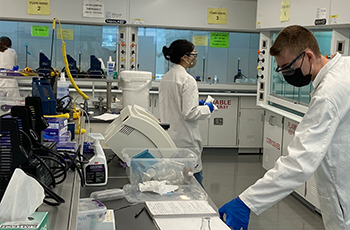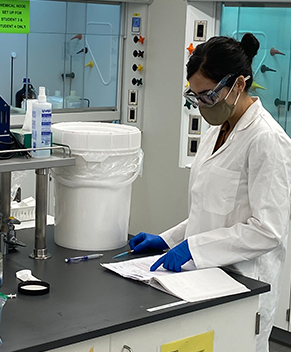Chemistry Faculty Offer Returning Students Hands-on Lab Experience
June 10, 2021 | By Zhuoying Lin
 Chemistry students Briana Bobek and Shane Douty participated in recently reopened hands-on lab classes at Tata Hall.
Chemistry students Briana Bobek and Shane Douty participated in recently reopened hands-on lab classes at Tata Hall.
Following the restrictive shutdowns caused by the COVID-19 pandemic, members of the Division of Physical Sciences took steps to get students safely back into the laboratory learning environment.
The Department of Chemistry and Biochemistry offered an optional in-person chem 143B (organic chemistry laboratory) bootcamp in spring quarter for students to gain hands-on laboratory experience.
The supplemental experience to chem 143B was arranged by assistant teaching professor in the department Jeremy Klosterman and Teaching Labs Director Mary Severs, while Staff Research Associate Cindy Tran oversaw the COVID measures in lab space and prepared all the chemicals and experiments for students.
“We set up this opportunity for students to do some of the experiments from 143B outside the actual classrooms, especially for those chemistry majors and graduating seniors who want to go on to do chemistry and lab-related careers because they didn’t have any in-person lab this last year,” Klosterman said.
The bootcamp was offered as chem 198 (department-approved directed group study) for students to earn additional academic credits. According to Klosterman, students took the class primarily for the experiments.
“Most of the students signed up even without any promise of the credits. They are interested, self-motivated and volunteered to come into the lab,” Klosterman said.
Sixteen students who enrolled in the class checked in once per week for a three-hour lab session at Tata Hall. Due to the small class size, students were able to perform experiments in each individual hood and obtain the NMR spectrum to analyze their compound for each experiment.
“While some aspects of the laboratory experience such as data analysis, written and oral communication skills, and iteration/contextualization of chemical theory can still be accomplished in a remote learning environment, familiarity with instrumentation and the development of precision in technique are unique to the ‘in-person’ environment,” vice chair of undergraduate education and associate teaching professor Thomas Bussey commented on the bootcamp opportunity.
 Briana Bobek
Briana Bobek
Given the time constraints, only a select portion of the standard chem 143B experiments were selected. The workload was cut in half compared to a regular chem 143B class. In order to foster a low-pressure learning experience, students were not directly assessed on the quality of the experimental outcome (e.g. yield) for each reaction. However, each subsequent step in the multi-step linear synthesis relies on the outcome (quantity and purity) of the previous reaction. So there's a built-in motivation to learn the necessary techniques at each stage.
“One limitation of the online lab experience is that it's straightforward to analyze artificially generated data—which is usually pretty high quality,” Klosterman said. “The difficulty in a real lab is that the quality of the data depends on whether you've made or isolated the correct material and whether you were able to carry out the necessary techniques to successfully purify your compound or not. That's one of the key aspects science students come to understand in hands-on experiences—how hard it can be to get good, reliable data."
The two graduate teaching assistants, Xiyuan Lu and Bobby Lucero, both commented that they had a positive teaching experience of the class.
“We get to teach less students at each session.It gives us more chances to pay attention to every student, their lab operations and what they are thinking. We have more flexibility to conduct teaching at higher quality,” Lu said.
Lucero observed students were excited to come and gain in-person lab experience.
“I knew that many students would be in upper division chemistry lab classes that have never actually taken lab or touched chemicals before. I wanted to do what I could to bridge this gap in lab experience for students,” Lucero said. “Because there is no emphasis on exams or assessments, students were more engaged and concerned about actually learning versus their grades.”
In light of in-person instruction for the upcoming fall quarter, Klosterman, Lu and Lucero each provided their advice for students who will enroll in lab courses after summer.
Klosterman:
Don’t wait until the last year to take 43A. 40A is the prerequisite for 43A, and the closer a student can take those two together, the more prepared the student is going to be for 43A in terms of conceptually understanding what is going on.
Lucero:
The TAs know students don't have much in-person experience during lab classes, so it's okay to ask for help. Everyone was affected by COVID: students, TAs and professors, so we're all going to try our best to have a smooth transition back to in-person classes.
Lu:
Always make safety your first priority. When a student comes to the lab this fall, be sure to pay attention to COVID safety measures as well as the original lab safety rules. On top of that, be confident and have fun.
Klosterman suggested in-person participation in lab space when COVID guidelines are carefully followed in fall.
“From an instructor’s standpoint, a hybrid lab class is just not fair to the students. In one, you are actually doing something and in the other you are just watching somebody do something else,” Klosterman said. “Chemistry/science is a practical field. It’s not just sitting around thinking deep thoughts—we do stuff.”
